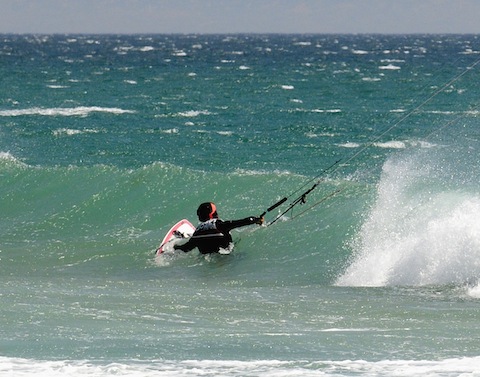The purpose of learning to body drag upwind is two fold. Firstly, whenever you come off your board you’re going to find yourself downwind of it. To prevent yourself losing boards or at the very best having to return to the beach every time you fall off it, you need to be able to body dragged up wind to retrieve it.
The ability to body drag up wind is also vital from a safety point of view. Once you can body drag up wind you can happily get yourself back to the point where you launched from whether you have a board on your feet or not.
Squeezing The Soap
Upwind Body dragging is very simple in theory and the principle is very similar to that of squeezing a bar of soap between your hands. Think of one hand as the pull from the kite and the other the resistance offered by your body against this pull. The result of these 2 opposing forces on the soap is that it shoots out in a perpendicular direction to both forces.
You are the soap.
To get yourself into the one-handed body dragging position you firstly need to change the angle of your body. Rather than just following the kite as we have been doing up to now you’ll want to change the angle of your body to resist the pull of the kite. It is this resistance which will “pop” you out in an upward direction.
Roughly speaking to start with, your body should be angled just about 10° up wind to start with. Once you have turned your body to this angle you need to turn onto your side. One of the commonest mistakes of upwind body dragging is that people stay lying on their stomach. At this angle your body provides only a small (in most cases!) area of resistance against the kite. By turning on your side (as most of us are wider in this dimension) you’re able to provide more resistance against the pull from the kite. Lock your legs out as stiff as a board and point your free hand in the direction you are going to give yourself extra grip in the water.

The kite should be as low in the window as you can manage (45 degrees is fine for now) and de powered, so it sits far forward in the window. You may want to trim the kite to aid this. Now the pull of the kite and your intended direction of travel are as close to each other as possible. The kite should also be still. Every time you move the kite it generates power, this power will pull you up and out of the water and downwind whenever it can. By keeping the kite still we reduce its power to a minimum and keep its angle close to our intended direction of travel.
If It Feels Like You’re Drowning…You’re Doing It Right
It’s very simple to know whether you’re upwind body dragging correctly as when you are, you will feel like you are drowning. It is a horrible sensation which I’m afraid to tell you doesn’t get much better with time. Often the worse it feels the more upwind you are going, so dig in and get it done.
The time a lot of people lose a lot of their upwind progress is when it comes to turn. Firstly you should be keeping your runs fairly long, as a guideline I would suggest a minimum of 20 m each to reduce the amount of turns you need to make. When you do come to turn, de power the kite fully and move it slowly across to the other side, keeping as much as your body in the water as an anchor as you possibly can. As soon as the kite is in position on the new side resume the upwind body dragging position and carry on. Many people try to get the turn done as quickly as possible and bring the kite rapidly from one side of the window to the other, this generally has the effect of lifting you out of the water and downwind, undoing all the good work you’ve just done.
Practice this until you can at least exit the water at the same point that you enter if not slightly higher.